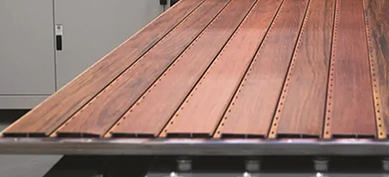The evolution of composite flooring has been marked by a continuous pursuit of balancing aesthetics with unparalleled performance. Within this landscape, architectural WPC flooring represents a significant leap forward, distinguishing itself from standard wood-plastic composite options through superior engineering and refined material science. While the core composition of wood flour and polymers provides a solid foundation, it is the advanced cap layer technology that truly unlocks the high-performance potential of this category.
Understanding the Fundamental Structure of Architectural WPC Flooring
To appreciate the role of the cap layer, one must first understand the basic anatomy of an architectural WPC flooring plank. Unlike simpler homogeneous sheets, these boards are engineered with a sophisticated multi-layer structure, each stratum serving a distinct and vital purpose. The foundation is a robust WPC core, a dense composite of wood flour or wood fibers, thermoplastic polymers (most commonly polyethylene, polypropylene, or PVC), and various stabilizing additives. This core is responsible for the product’s defining characteristics: exceptional dimensional stability, resistance to moisture absorption, and structural integrity that prevents warping and cupping.
However, the core alone, while strong, is not inherently equipped to handle the daily abrasion, stains, and impacts that a floor surface must endure. It is also not optimized for high-fidelity visual reproduction. This is where the cap layer, also known as the wear layer or overlay, enters the equation. In architectural WPC flooring, the cap is not a mere thin coating but a distinct, co-extruded layer of pure polymer-based material engineered for maximum surface performance. This dedicated layer transforms the plank from a stable substrate into a complete, high-performance flooring system. The transition from a simple protective coating to a sophisticated, multi-functional cap layer is what separates entry-level products from true architectural grade WPC.
The Composition and Engineering of the Advanced Cap Layer
The efficacy of the cap layer is a direct result of its specialized composition and manufacturing process. While the core utilizes wood flour as a filler, the cap layer is typically formulated with a high percentage of premium polymers and fortified with a suite of performance-enhancing additives. Key components often include:
- Ultra-Fine Mineral Fillers: Materials like aluminum oxide or corundum are integrated into the polymer matrix. These incredibly hard particles are the primary agents responsible for the exceptional scratch and scuff resistance that defines high-quality architectural WPC flooring.
- UV Stabilizers: These additives are crucial for mitigating the fading effects of direct sunlight. They absorb and reflect ultraviolet radiation, ensuring that the floor’s color remains vibrant and consistent over time, even in sun-drenched rooms.
- Antistatic Agents: These compounds help reduce the buildup of static electricity, which attracts dust and dirt. This contributes to easier cleaning and maintenance.
- Bioplastic materials are also being explored for use in cap layers, aligning with growing demands for sustainable building products.
The manufacturing process is equally critical. The cap layer is not laminated or glued on in a secondary step; instead, it is co-extruded simultaneously with the core layer. This process involves two or more extruders melting the different compound formulations (core and cap) and feeding them into a single die head, where they fuse together permanently while still in a molten state. This creates a monolithic bond that is physically inseparable, eliminating any risk of delamination—a common failure point in inferior products that use applied films. The thickness of this cap layer is a key differentiator, with architectural grade products featuring a significantly thicker and more robust cap than standard offerings, directly correlating to a longer lifespan and better performance.
Enhanced Durability: The Primary Shield Against Wear
The most immediate and tangible benefit of the advanced cap layer is a dramatic increase in the floor’s durability. This manifests in several key areas of performance that are critical for wholesalers and buyers to understand.
Superior Abrasion and Scratch Resistance: The inclusion of hard mineral particles like aluminum oxide creates a surface that is highly resistant to daily wear. This is quantitatively measured by standardized tests, with results often communicated as AC ratings (Abrasion Class). Architectural WPC flooring typically achieves high AC ratings (e.g., AC4 for heavy commercial use or AC5 for extra-heavy commercial), indicating its suitability for spaces with high foot traffic, rolling chairs, and potential contact with grit and debris. This resilience ensures the floor maintains its like-new appearance for years, reducing long-term maintenance costs and the need for premature replacement.
Stain and Moisture Immunity: The non-porous, pure polymer nature of the cap layer creates an impermeable barrier. Unlike natural wood or even the WPC core which has some minor porosity, the cap prevents liquids—from water and juice to more aggressive substances like coffee, wine, or chemical cleaners—from penetrating the surface. This allows for spills to be simply wiped away without leaving a permanent stain. Furthermore, this complete waterproof seal complements the core’s moisture resistance, making the entire plank 100% waterproof and ideal for problem areas like bathrooms, kitchens, basements, and commercial washrooms.
Impact Resistance and Structural Integrity: The flexibility and toughness of the polymer cap allow it to absorb and dissipate energy from impacts, such as a dropped utensil or a falling object. This helps to prevent denting and cracking, protecting the aesthetic and structural integrity of the floor. The co-extrusion process ensures that this protective function is integral to the product, as the bond between the cap and the core will not separate under stress.
Elevated Aesthetics: Beyond Basic Reproduction
While durability is paramount, the modern market demands beauty equal to performance. The cap layer technology is instrumental in achieving the sophisticated aesthetics that allow architectural WPC flooring to compete with natural materials.
High-Definition Printing and Embossing: The smooth, consistent surface of the cap layer provides a perfect canvas for high-resolution decorative prints. This technology enables the precise reproduction of complex wood species, with authentic grain patterns, mineral veining, and color variation. More importantly, advanced manufacturing allows for embossing in register (EIR), a process where a textured surface is stamped into the cap layer that exactly aligns with the printed grain pattern underneath. This creates a tactile experience that mimics the feel of real wood planks, down to the subtle pores and grain variations, enhancing the realism far beyond what visual printing alone can achieve.
Gloss Levels and Visual Depth: The cap layer can be finished with varying degrees of sheen, from matte and satin to semi-gloss, to suit different design preferences. Furthermore, the clarity and composition of the polymer can impart a sense of visual depth, making the decorative layer appear beneath a clear, protective surface—much like a high-quality varnish on hardwood. This contributes to a premium look and feel.
Hygienic and Maintenance Advantages
The functional benefits of the cap layer extend into aspects of cleanliness and upkeep, which are significant factors in specification for both residential and commercial buyers.
The seamless, non-porous barrier is inherently resistant to the growth of mold, mildew, and bacteria. This contributes to a healthier indoor environment by minimizing allergens and potential irritants. This mold and mildew resistance is a critical advantage in humid climates or moisture-prone installations.
From a maintenance perspective, the cap layer simplifies care dramatically. There is no need for waxing, sealing, or polishing. Routine cleaning requires only sweeping and occasional damp mopping with a pH-neutral cleaner. The surface’s resistance to common chemical cleaners means it can be sanitized effectively without risk of damaging the finish. This low-maintenance profile translates into significant long-term savings on cleaning products, labor, and time, a key selling point for facility managers and homeowners alike.

 English
English Español
Español



